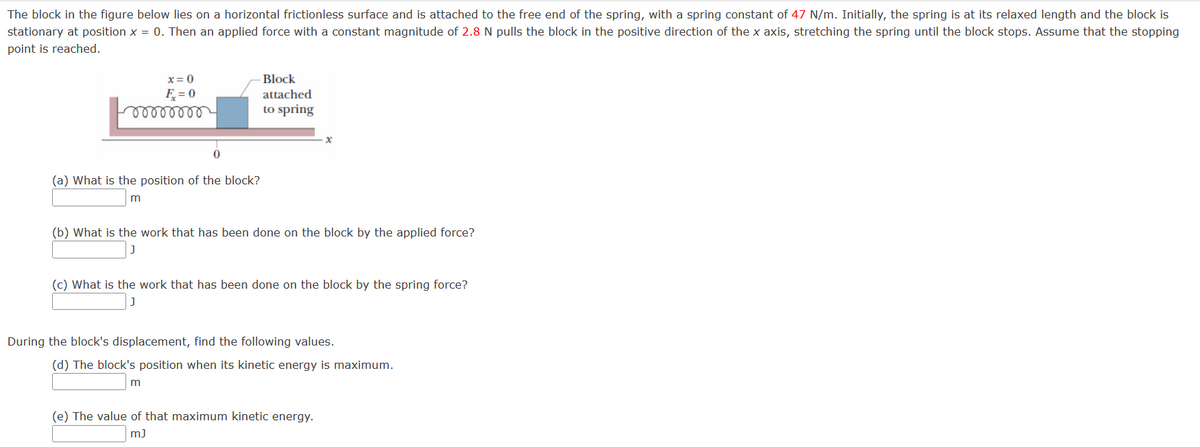ionary at position x = 0. Then an applied force with a constant magnitude of 2.8 N pulls the block in the positive direction of the x axis, stretching the spring until the block stops. Assume that the stopping t is reached. Block attached to spring X= 0 F = 0 (a) What is the position of the block? (b) What is the work that has been done on the block by the applied force? (c) What is the work that has been done on the block by the spring force? ing the block's displacement, find the following values. (d) The block's position when its kinetic energy is maximum. m (e) The value of that maximum kinetic energy. m)
ionary at position x = 0. Then an applied force with a constant magnitude of 2.8 N pulls the block in the positive direction of the x axis, stretching the spring until the block stops. Assume that the stopping t is reached. Block attached to spring X= 0 F = 0 (a) What is the position of the block? (b) What is the work that has been done on the block by the applied force? (c) What is the work that has been done on the block by the spring force? ing the block's displacement, find the following values. (d) The block's position when its kinetic energy is maximum. m (e) The value of that maximum kinetic energy. m)
Physics for Scientists and Engineers
10th Edition
ISBN:9781337553278
Author:Raymond A. Serway, John W. Jewett
Publisher:Raymond A. Serway, John W. Jewett
Chapter7: Energy Of A System
Section: Chapter Questions
Problem 47AP: An inclined plane of angle = 20.0 has a spring of force constant k = 500 N/m fastened securely at...
Related questions
Topic Video
Question

Transcribed Image Text:The block in the figure below lies on a horizontal frictionless surface and is attached to the free end of the spring, with a spring constant of 47 N/m. Initially, the spring is at its relaxed length and the block is
stationary at position x = 0. Then an applied force with a constant magnitude of 2.8 N pulls the block in the positive direction of the x axis, stretching the spring until the block stops. Assume that the stopping
point is reached.
x = 0
Block
attached
F = 0
to spring
(a) What is the position of the block?
(b) What is the work that has been done on the block by the applied force?
(c) What is the work that has been done on the block by the spring force?
During the block's displacement, find the following values.
(d) The block's position when its kinetic energy is maximum.
(e) The value of that maximum kinetic energy.
m)
Expert Solution
This question has been solved!
Explore an expertly crafted, step-by-step solution for a thorough understanding of key concepts.
Step by step
Solved in 2 steps with 2 images

Knowledge Booster
Learn more about
Need a deep-dive on the concept behind this application? Look no further. Learn more about this topic, physics and related others by exploring similar questions and additional content below.Recommended textbooks for you

Physics for Scientists and Engineers
Physics
ISBN:
9781337553278
Author:
Raymond A. Serway, John W. Jewett
Publisher:
Cengage Learning

Physics for Scientists and Engineers with Modern …
Physics
ISBN:
9781337553292
Author:
Raymond A. Serway, John W. Jewett
Publisher:
Cengage Learning

Principles of Physics: A Calculus-Based Text
Physics
ISBN:
9781133104261
Author:
Raymond A. Serway, John W. Jewett
Publisher:
Cengage Learning

Physics for Scientists and Engineers
Physics
ISBN:
9781337553278
Author:
Raymond A. Serway, John W. Jewett
Publisher:
Cengage Learning

Physics for Scientists and Engineers with Modern …
Physics
ISBN:
9781337553292
Author:
Raymond A. Serway, John W. Jewett
Publisher:
Cengage Learning

Principles of Physics: A Calculus-Based Text
Physics
ISBN:
9781133104261
Author:
Raymond A. Serway, John W. Jewett
Publisher:
Cengage Learning

University Physics Volume 1
Physics
ISBN:
9781938168277
Author:
William Moebs, Samuel J. Ling, Jeff Sanny
Publisher:
OpenStax - Rice University

Physics for Scientists and Engineers: Foundations…
Physics
ISBN:
9781133939146
Author:
Katz, Debora M.
Publisher:
Cengage Learning

Classical Dynamics of Particles and Systems
Physics
ISBN:
9780534408961
Author:
Stephen T. Thornton, Jerry B. Marion
Publisher:
Cengage Learning